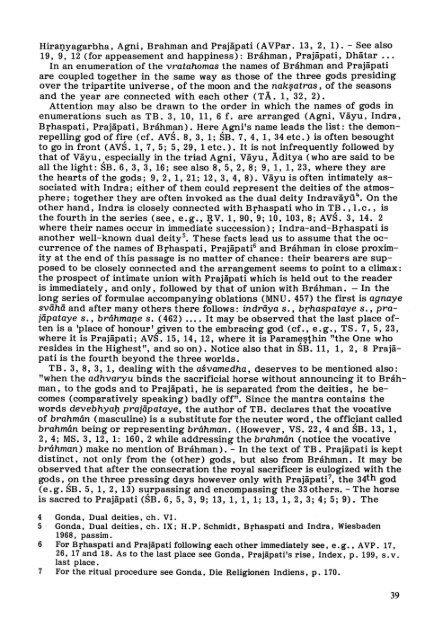Prajapati's relations with Brahman, Brhaspati and Brahma - DWC
Prajapati's relations with Brahman, Brhaspati and Brahma - DWC
Prajapati's relations with Brahman, Brhaspati and Brahma - DWC
Create successful ePaper yourself
Turn your PDF publications into a flip-book with our unique Google optimized e-Paper software.
HiraI;1yagarbha, Agni, <strong><strong>Brahma</strong>n</strong> <strong>and</strong> Prajäpati (AVPar. 13, 2, 1). - See also<br />
19,9,12 (for appeasement <strong>and</strong> happiness): Bráhman, Prajäpati, Dhätar ...<br />
In an enumeration of the vratahomas the names of Bráhman <strong>and</strong> Prajäpati<br />
are coup led together in the same way as those of the three gods presiding<br />
over the tripartite universe , of the moon <strong>and</strong> the nak~atras, of the seasons<br />
<strong>and</strong> the year are connected <strong>with</strong> each other (T Ä. 1, 32, 2).<br />
Attentiop. mayalso be drawn to the order in which the names of gods in<br />
enumerations such as TB. 3, 10, 11, 6 f. are arranged (Agni, Väyu, Indra,<br />
<strong>Brhaspati</strong>, Prajäpati, Bráhman). Here Agni's name leads the list: the demonrepelling<br />
god of fire (cf. AVS. 8, 3, 1; SB . 7, 4, 1, 34 etc.) is of ten besought<br />
to go in front (AVS. 1, 7,5; 5,29, 1 etc.). It is not infrequently followed by<br />
that of Väyu"especially in the triad Agni, Väyu, Äditya (who are said to be<br />
all the light: SB. 6, 3, 3,16; see also 8, 5, 2, 8; 9,1,1, 23, where they are<br />
the heartsofthe gods; 9,2,1,21; 12, 3, 4, 8). Väyuisoften intimately aSsociated<br />
<strong>with</strong> Indra; either of them could represent the deities of the atmosphere;<br />
together they are of ten invoked as the dual deity Indraväyii4. On the<br />
other h<strong>and</strong>, Indra is closely connected <strong>with</strong> <strong>Brhaspati</strong> who in T~ . , 1. c., is<br />
the fourth in the series (see, e.g., lJV. 1, 90, 9; 10, 103,8; AVS. 3, 14. 2<br />
where their names occur in immediate succession) ; Indra-<strong>and</strong>-<strong>Brhaspati</strong> is<br />
another well-known dual deitys. These facts lead us to assume that the occurrence<br />
of the names of <strong>Brhaspati</strong>, Prajäpati 6 <strong>and</strong> Bráhman in close proximity<br />
at the end of this passage is no matter of chance: their bearers are supposed<br />
to be closely connected <strong>and</strong> the arrangement seems to point to a climax:<br />
the prospect of intimate union <strong>with</strong> Prajäpati which is held out to the reader<br />
is immediately, <strong>and</strong> only, followed by that of union <strong>with</strong> Bráhman. - In the<br />
long series of formulae accompanying oblations (MNU. 457) the first is agnaye<br />
svëihëi <strong>and</strong> after many others there follows: indrëiya S., brhaspataye S., prajëipataye<br />
S., bráhmalJe s. (462) .... It may be observed that the last place often<br />
is a 'place of honour' ,given to the embracmg god (cf., e. g., TS. 7, 5, 23,<br />
where it is Prajäpati; AVS. 15, 14, 12, where it is Param~!ilthin "the One who<br />
resides in the Highest", <strong>and</strong> so on). Notice also that in SB. 11, 1, 2, 8 Prajäpati<br />
is the fourth beyond the three worlds.<br />
TB. 3, 8, 3, 1, dealing <strong>with</strong> the asvamedha, deserves to be mentioned also:<br />
"when the adhvaryu binds the sacrificial horse <strong>with</strong>out announcing it to Bráhman,<br />
to the gods <strong>and</strong> to Prajäpati, he is separated from the deities , he becomes<br />
(comparatively speaking) badly off". Since the mantra contains the<br />
words devebhya1;t prajëipataye, the author of TB. declares that the vocative<br />
of brahmán (masculine) is a substitute for the neuter word, the officiant called<br />
brahmán being or representing bráhman. (However, VS. 22, 4 <strong>and</strong> SB. 13, 1,<br />
2,4; MS. 3, 12, 1: 160,2 while addressing the brahmán (notice the vocative<br />
bráhman) make no mention of Bráhman). - In the text of TB. Prajäpati is kept<br />
distinct, not only from the (ot her) gods, but also from Bráhman. It may be<br />
observed that af ter the consecration the royal sacrifieer is eulogized <strong>with</strong> the<br />
gods, ~m the three pressing days however only <strong>with</strong> PrajäpatC, the 34th god<br />
(e.g. SB. 5,1,2,13) surpassing <strong>and</strong> encompassing the 330thers. - The horse<br />
is sacred to Prajäpati (SB. 6,5, 3, 9; 13, 1, 1, 1; 13, 1, 2, 3; 4; 5; 9). The<br />
4 Gonda. Dual deities • ch. VI.<br />
5 · Gonda. Dual deities • ch. IX; H. P. Schmidt. <strong>Brhaspati</strong> <strong>and</strong> Indra. Wiesbaden<br />
1968. passim.<br />
6 For <strong>Brhaspati</strong> <strong>and</strong> Prajäpati following each other immediately see, e. g .• AVP. 17.<br />
26. 17 <strong>and</strong> 18. As to the last place see Gonda. Prajäpati 's rise. Index. p. 199. s. v .<br />
last place.<br />
7 For the ritual procedure see Gonda. Die Religionen Indiens. p. 170.<br />
39
















